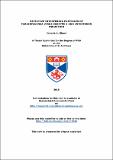Files in this item
Defective interfering particles of parainfluenza virus subtype 5 and interferon induction
Item metadata
| dc.contributor.advisor | Randall, R. E. | |
| dc.contributor.author | Short, John A. L. | |
| dc.coverage.spatial | 234 | en_US |
| dc.date.accessioned | 2015-07-27T14:12:00Z | |
| dc.date.available | 2015-07-27T14:12:00Z | |
| dc.date.issued | 2015 | |
| dc.identifier.uri | https://hdl.handle.net/10023/7036 | |
| dc.description.abstract | The innate immune response is the first line of defence against virus infection. Cells contain a diverse array of pathogen recognition receptors (PRRs) that are able to recognise multiple pathogen associated molecular patterns (PAMPS) that present themselves during virus infection. The RIG-I (Retinoic acid inducible–gene-I) and MDA5 (melanoma differentiation-associated gene 5) PRRs detect specific viral RNA ligands and subsequently induce the expression of the cytokine Interferon-β (IFN-β). IFN-β is secreted, acting on the infected cell and neighbouring uninfected cells to generate an antiviral state that is hostile to virus transcription, replication and dissemination, whilst also orchestrating adaptive immune responses. Given IFN-β's crucial cellular antiviral role, understanding its induction is of great importance to developing future antiviral drugs and vaccine strategies. Using A549 reporter cells in which GFP expression is under the control of the IFN-β promoter, we show that there is a heterocellular response to parainfluenza virus 5 (PIV5) and infection with other negative sense RNA viruses. Only a limited number of infected cells are responsible for IFN-β induction. Using PIV5 as a model, this thesis addresses the nature of the PAMPs that are responsible for inducing IFN-β following PIV5 infection. The previous work has shown that PIV5 Defective Interfering particle (DI) rich virus preparations acted as a better inducer of IFN-β compared to DI poor stocks. DIs are incomplete virus genomes produced during wild-type virus replication as a result of errors in the viral polymerase. To investigate this further, A549 Naïve, MDA5/RIG-I/LGP2 Knock down reporter cells were infected with PIV5 W3 at a low MOI to examine the inverse correlation of NP and GFP of DIs generated during virus replication and not from the initial infection. GFP+ve cells were cell sorted, and using QPCR it was found that cells that have the IFN-β promoter activated contain large amounts of DIs relative to GFP-ve cells. This data supports the Randall group’s findings that DIs generated during errors of wild-type replication by the viral RNA polymerase are the primary PAMPs that induce of IFN-β, as opposed to PAMPs being generated during normal wild-type virus replication. | en_US |
| dc.language.iso | en | en_US |
| dc.publisher | University of St Andrews | |
| dc.subject.lcc | QR187.5S5 | |
| dc.subject.lcsh | Interferon inducers | en_US |
| dc.subject.lcsh | Parainfluenza viruses | en_US |
| dc.title | Defective interfering particles of parainfluenza virus subtype 5 and interferon induction | en_US |
| dc.type | Thesis | en_US |
| dc.type.qualificationlevel | Doctoral | en_US |
| dc.type.qualificationname | PhD Doctor of Philosophy | en_US |
| dc.publisher.institution | The University of St Andrews | en_US |
This item appears in the following Collection(s)
Items in the St Andrews Research Repository are protected by copyright, with all rights reserved, unless otherwise indicated.

